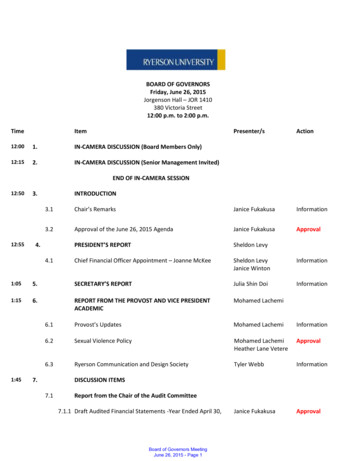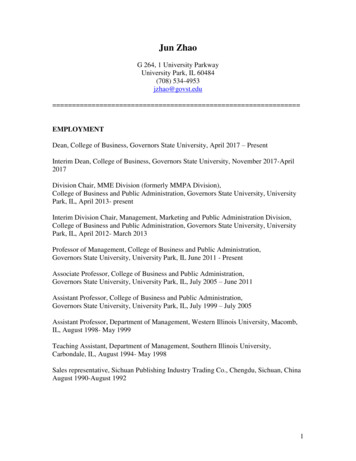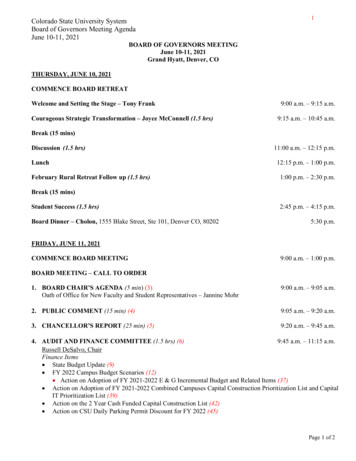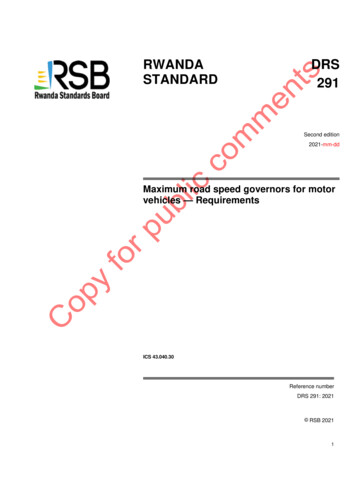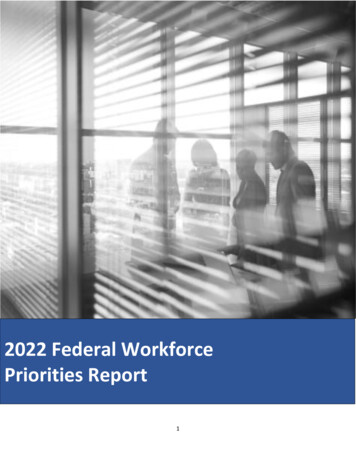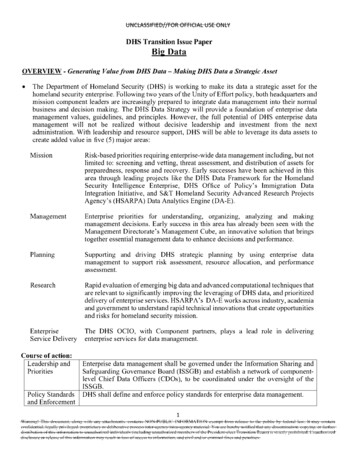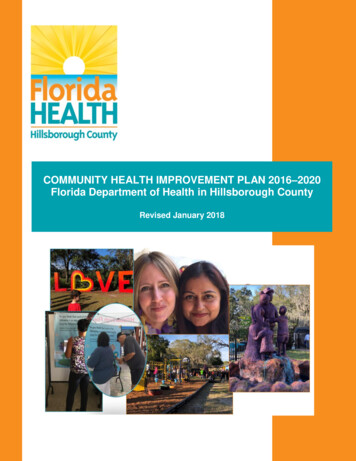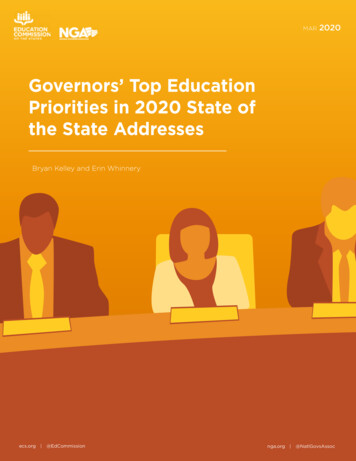
Transcription
MAR2020Governors’ Top EducationPriorities in 2020 State ofthe State AddressesBryan Kelley and Erin Whinnery1nga.org @EdCommission@NatlGovsAssocecs.orgnga.org @NatlGovsAssoc
In laying out policy priorities in their 2020We are committed to go the distanceState of the State addresses, governorsrecognized the role the public educationbecause we know our children’s futuresystem plays in supporting strongis at risk. Education is the foundationeconomies. Often citing the need to alignof our economy and our quality of life.education with the 21st century’s knowledgeEverything, including our future, beginseconomy, governors agreed that a high-with how well we educate our children.quality education is the key to both anindividual’s and the state’s success. AlabamaAnd that is significantly affected by theGov. Kay Ivey echoed the sentiments ofkind of beginnings we provide for them.many governors when she said, “For us toWe cannot let them down.prepare today’s students for tomorrow’sGov. David Igeopportunities, it is time we get serious.”HAWAIIEach year, Education Commission of the States tracks, analyzes and identifies trends in educationpolicy accomplishments and proposals featured in governors’ State of the State addresses. To date,43 governors have delivered their 2020 address. The top education priorities across the states andterritories span the entire education spectrum, pre-K through the workforce.Governors in at least* 34states emphasized the importance of K-12 CAREER AND TECHNICALEDUCATION (CTE) and WORKFORCE DEVELOPMENT PROGRAMS.Governors in at least 30states mentioned K-12 SCHOOL FINANCE, including NEW INVESTMENTSfor certain STUDENT POPULATIONS.At least 25governors highlighted POSTSECONDARY AFFORDABILITY as a top priority for their state.At least 25governors recognized the value of investing in TEACHERS and addressed policyrelevant to TEACHER COMPENSATION AND BENEFITS.At least 19governors called attention to investments in EARLY LEARNING OPPORTUNITIES forchildren in their states.Governors in at least 18states highlighted the connections between STUDENT HEALTH and studentperformance.Click here for complete summaries of educationpolicy priorities outlined in each governor’sState of the State address.*The counts listed throughout this resource reflect Education Commission of the States’ best efforts to analyze governors’ remarks.2ecs.org @EdCommission
CTE and Workforce DevelopmentWorkforce development efforts, ranging fromK-12 CTE programs to workforce trainingOur goal is nothing short of meaningfulcenters, were a priority for many governors incareer training for anyone who wants it.2020. This year, at least 34 governors includedworkforce development in their State of theState address. Many emphasized the roleGov. Jay InsleeWASHINGTONof apprenticeship programs and work-based learning experiences in preparing individuals for theworkforce, with some governors praising recent efforts and others announcing the launch of newinvestments and programs. Several governors called attention to the unique roles played by communitycolleges and workforce training centers in both preparing students and meeting employer needs.IdahoProposed ongoing funding for the Idaho Jobs Corps community collegeGov. Brad Littleprogram to connect 16- to 24-year-olds to in-demand jobs.IllinoisPraised investments in the Illinois Works program to recruit constructionGov. J.B. Pritzkerapprentices in a way that ensured the jobs were inclusive and attracted adiverse workforce.IndianaHighlighted that more than 23,000 people have enrolled in the WorkforceGov. EricReady Programs in the past 3 years, with 10,000 of them having completed aHolcombcertificate program as of the start of this year.MaineProposed increased funding for equipment upgrades that will help to trainGov. Janet Millsnearly 8,000 CTE students to address Maine’s workforce shortage.MississippiProposed a 100 million investment in workforce development, which willGov. Tate Reevesinclude training students in apprenticeships, expanding community collegegrants and assisting current workers.New JerseyProposed Jobs NJ, a plan to align the education system with the needs of theGov. Phil Murphyworkforce, provide ongoing job training and close equity gaps that serve as abarrier to job training and skills development.To learn more about state policy actions in this area, visit ourWorkforce Development Key Issue page.3nga.org @NatlGovsAssoc
K-12 FinanceAt least 30 governors spoke about K-12school finance in their State of the StateBudgets serve as roadmaps for theaddress. They celebrated increases infuture — which is why we made historicavailable funding or identified challengesinvestments into our education system.to equitable funding. Many governorshighlighted new investments for certainGov. Chris SununuNEW HAMPSHIREstudent populations (e.g., studentsdesignated as low income or with special education needs) and capital construction projects. Othersspoke to tensions around increased local property taxes to fund K-12 education. Additionally, at leastfive governors specifically mentioned recent reviews of — or promised to soon review — the schoolfunding formula.ArizonaHighlighted results-based funding and proposed expanding it to continue toGov. Doug Duceyrecognize the achievements and needs of schools designated as high-poverty.KansasHighlighted legislation to end the legal battle over school finance and calledGov. Laura Kellyit a critical first step in reevaluating every corner of the state’s educationecosystem.OklahomaProposed reviewing the school funding formula and allowing voters to unlockGov. Kevin Stittmore local dollars.PennsylvaniaProposed 435 million in new investments in public education, including a 100Gov. Tom Wolfmillion increase in the fair funding formula, an additional 25 million increasefor special education and a 30 million increase for high-quality early childhoodeducation.UtahDiscussed the need for tax modernization to have sustainable funding forGov. Gary Herbertpublic education.WisconsinInvested more than 500 million in K-12 education, including the state’s firstGov. Tony Eversspecial education increase in 10 years, and highlighted his use of veto authorityto add almost 100 million more in per-pupil aid to the state budget.To learn more about state policy actions in this area, visit our School Funding Key Issue page.4ecs.org @EdCommission
Postsecondary AffordabilityMany governors recognized that well-paying careersincreasingly require some form of education after highAnd so the model of where weschool. At least 25 governors spoke to the importancethink about a four-year-model,of affordable postsecondary opportunities in their 2020on-campus thing is beingState of the State address. Generally, such proposals takeone of two approaches: addressing the cost of collegechallenged. . The economicstuition or increasing access to financial aid resources.are shifting. As costs increase,Additionally, at least nine governors either recognizedstudents seek more affordablecurrent efforts or proposed new programs to makeoptions.college tuition-free for qualifying students.Gov. Doug BurgumNORTH DAKOTAConnecticutHighlighted a new initiative from the University of Connecticut wherebyGov. Ned Lamontstudents of families earning less than 50,000 will receive free tuition andcommunity colleges will be debt-free for recent high school graduates.IdahoCommended tuition freezes for resident undergraduate students in 2020 asGov. Brad Littlepart of strategic efforts to make college more accessible to Idahoans.IowaProposed a 2.8 million increase in funding for the Last Dollar ScholarshipGov. Kim Reynoldsprogram.LouisianaCommitted to funding the TOPS and Go Grants scholarships at the highestGov. John BelEdwardslevel ever and proposed more than 30 million in his budget to do so.MichiganProposed passing Michigan Reconnect legislation, which would provideGov. GretchenWhitmertuition-free skills training and degree programs for adult learners.VirginiaProposed an additional 1,000 stipend for transportation, child care or otherGov. RalphNorthamnontuition postsecondary costs for Pell Grant recipients who wish to enter ahigh-demand field and commit to community service.To learn more about state policy actions in this area, visit ourPostsecondary Affordability Key Issue page.5nga.org @NatlGovsAssoc
Teacher Compensation and BenefitsMany governors acknowledged the hard work andcontributions of teachers. At least 25 governorsThese [teacher salary increases]discussed teacher compensation and recruitment/are critical investments. Theyretention efforts in their 2020 State of the Statewill help attract the best and theaddress. Although several governors acknowledgedbrightest young people into thethey face teacher shortages and high turnoverrates, many praised recent increases in teacher payor commitment to future pay increases as ways toprofession and keep our highlysuccessful and experiencedaddress these two challenges. Others specificallyteachers where they are neededaddressed increases in minimum salaries for teachers.the most: in the classroom.A few governors highlighted or proposed loanforgiveness or scholarship programs as a potentialGov. Henry McMasterSOUTH CAROLINAway to recruit and retain their teacher workforce.AlaskaDirected the state commissioner of education to assemble a working group madeGov. Mikeup of teachers, administrators and others to review the root causes of teacherDunleavyretention and recruitment issues — including working conditions and benefits — inorder to develop a plan to address the issue.DelawarePraised the enactment of a parental leave policy for educators, which enablesGov. JohnCarneyparents to spend 12 weeks at home with their newborn babies.FloridaProposed a budget that places an emphasis on bonuses for teachers and principalsGov. RonDeSantisin Title I schools, with bonuses of up to 7,500 and 10,000, respectively.GeorgiaProposed including a 2,000 pay raise for all public school educators in theGov. BrianKempbudget, with the goal of enhancing teacher recruitment and retention andKentuckyEmphasized that a pension should be treated as a promise, recognized the serviceGov. AndyBeshearof educators and committed to fully funding teacher pension obligations in theMaineCalled for increased funding for the Educators for Maine Loan ForgivenessGov. JanetMillsprogram to incentivize teachers to work in underserved areas.improving educational outcomes.budget.To learn more about state policy actions in this area, visit our Teaching Key Issue page.6ecs.org @EdCommission
Early LearningThis year, many governors emphasized theimportance of early learning opportunities forEarly childhood education isn’t justchildren in their states. At least 19 governorsabout giving our kids a great start inaddressed early learning in their 2020 State oflife. Every dollar invested in high-the State address. Several governors praisedquality preschool produces a 7recent investments in, and expansions of, earlyreturn on investment due to higherlearning. Additionally, at least 13 governorsproposed expansions of preschool, pre-Kearnings, lower special educationor kindergarten access, either universally orneeds, greater tax revenues, lessfor targeted populations. Several governorsdependency on public assistancehighlighted the importance of early childhoodand lower crime rates.education for achievements and outcomes laterin life, including career readiness.Gov. Jared PolisCOLORADODelawarePraised the First Chance Initiative, which promotes learning readinessGov. John Carneythrough literacy, health and parent-child engagement programs in partnershipwith food banks, libraries and other nonprofits.Hawai’iDeclared that by the end of this decade, every 3- and 4-year-old in Hawai'iGov. David Igeshould have the opportunity to attend child care or a preschool program.IowaCalled for the expansion of Early Childhood Tax Credits in an effort to makeGov. Kim Reynoldschild care more affordable.MissouriDiscussed a 33.5 million federal preschool development grant aimed atGov. Mike Parsoncreating a more effective, high-quality early learning system.Rhode IslandProposed an increase of more than 50% in the number of high-quality publicGov. Gina Raimondopre-K classrooms throughout the state.South CarolinaCalled for the expansion of the full-day, 4-year-old kindergarten program toGov. Henry McMasterserve all children from families with lower incomes.To learn more about state policy actions in this area, visit ourEarly Childhood Education Key Issue page.7nga.org @NatlGovsAssoc
Student HealthAt least 18 governors remarked on the need toaddress students’ mental and physical health, asWe know that environmentalwell as the connections between health and studentfactors directly affect studentoutcomes. Proposed investments in student healthperformance. And we know howinclude increasing access to school-based, mental- orbehavioral-health resources and expanding school mealto fix this problem.programs. Several governors expressed concerns aboutenvironmental issues and risky student behavior, suchGov. Tom WolfPENNSYLVANIAas lead in schools and youth vaping.CaliforniaHighlighted a bipartisan, statewide school bond measure that, if approvedGov. Gavin Newsomby voters, may mean more school buildings free of lead and toxic mold.MassachusettsPraised the development of a legal framework to regulate and respond toGov. Charlie Bakervaping by teens.New YorkProposed increasing the number of community schools and after-schoolGov. Andrew Cuomoservices as part of an increase in wraparound health services.TennesseeVoiced his intention to expand the school-based behavioral health liaisonGov. Bill Leeprogram to all 95 counties, up from 36, to help teachers and schoolssupport students’ mental health.West VirginiaProposed an additional 2 million for the state department of education'sGov. Jim Justicebackpack program, which provides students experiencing food insecuritywith weekend meals.WisconsinPraised the Farm to School program and announced a new Farm toGov. Tony EversFork program to expand intrastate produce commerce to universities andtechnical colleges.To learn more about state policy actions in this area, visit ourSchool Climate Key Issue page.8ecs.org @EdCommission
About the AuthorsBryan KelleyAs a policy researcher, Bryan works on tracking legislation, answering informationrequests and contributing to other policy team projects. Prior to joining EducationCommission of the States, he worked in public policy research at the NationalConference of State Legislatures in Denver and AcademyHealth in Washington, D.C.; healso earned a master's degree from the University of Manchester and a bachelor'sdegree from Colorado College. When Bryan is not busy researching education policy,he can be found hiking around Colorado, trying a new cafe or brewery, or planning hisnext vacation destination with his wife. Contact Bryan at bkelley@ecs.org or303.299.3696.Erin WhinneryAs a project manager, Erin supports the foundational research services at EducationCommission of the States and has a particular interest in the areas of postsecondaryaccess and success. Before joining the organization, Erin earned her master's degree inhigher education administration from the University of Denver and a bachelor's degreein English from Boston College. On weekends, Erin is an amateur crafter and quilter.Contact Erin at ewhinnery@ecs.org or 303.299.3654.ACKNOWLEDGMENTSThe authors thank Lexi Anderson, Emily Brixey, Ben Erwin, Alyssa Evans, Cassidy Francies, TiffanyMcDole, Eric Syverson — all of Education Commission of the States — for their contributions to thisresource.9
About NGAFounded in 1908, the National Governors Association is the voice of the nation’sgovernors and one of the most respected public policy organizations in thecountry. The association’s members are the governors of the 55 states, territoriesand commonwealths. Members come to the association from across the politicalspectrum, but NGA itself is boldly nonpartisan. 2020 by Education Commission of the States. All rights reserved. Education Commission of the States encourages its readers to share ourinformation with others.Education Commission of the States 700 Broadway Suite 810 Denver, CO 80203
State of the State addresses, governors recognized the role the public education system plays in supporting strong economies. Often citing the need to align education with the 21st century's knowledge economy, governors agreed that a high-quality education is the key to both an individual's and the state's success. Alabama Gov. Kay Ivey echoed the sentiments of many governors when she .



